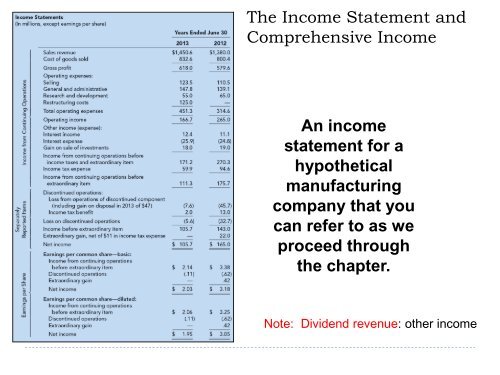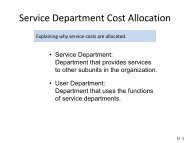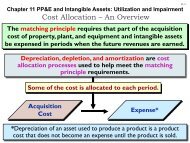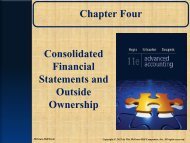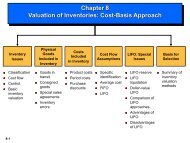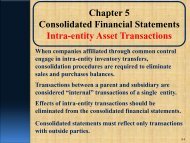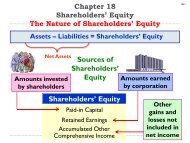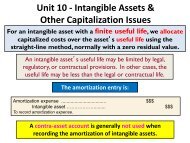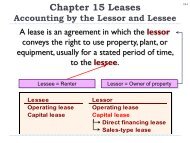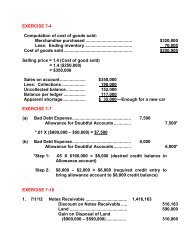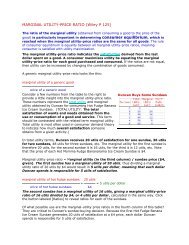Unit - Anna Lee
Unit - Anna Lee
Unit - Anna Lee
You also want an ePaper? Increase the reach of your titles
YUMPU automatically turns print PDFs into web optimized ePapers that Google loves.
The Income Statement and<br />
Comprehensive Income<br />
An income<br />
statement for a<br />
hypothetical<br />
manufacturing<br />
company that you<br />
can refer to as we<br />
proceed through<br />
the chapter.<br />
Note: Dividend revenue: other income
4-2<br />
Separately Reported Items<br />
Reported separately, net of taxes:<br />
Discontinued<br />
operations<br />
Extraordinary<br />
items
4-3<br />
Intraperiod Income Tax Allocation<br />
Income Tax Expense must be associated with<br />
each component of income that causes it.<br />
Show Income Tax<br />
Expense related to<br />
Income from Continuing<br />
Operations.<br />
Report effects of<br />
Discontinued Operations and<br />
Extraordinary Items net of<br />
related income tax effect.
4-4<br />
Discontinued Operations<br />
As part of the continuing process to converge U.S. GAAP and<br />
international standards, the FASB and IASB have been working<br />
together to develop a common definition and a common set of<br />
disclosures for discontinued operations.<br />
The proposed ASU (Accounting Standards Updates) defines a<br />
discontinued operation as a “component” that either (a) has<br />
been disposed of or (b) is classified as held for sale, and<br />
represents one of the following:<br />
1. a separate major line of business or major geographical area<br />
of operations,<br />
2. part of a single coordinated plan to dispose of a separate<br />
major line of business or geographical area of operations, or<br />
3. a business that meets the criteria to be classified as held for<br />
sale on acquisition.
Reporting Discontinued Operations<br />
Reporting for Components Sold<br />
4-5<br />
1. Income or loss from<br />
operations of the component<br />
from the beginning of the<br />
reporting period to the<br />
disposal date.<br />
2. Gain or loss on the disposal of<br />
the component’s assets.<br />
Reporting for Components Held For Sale<br />
1. Income or loss from<br />
operations of the component<br />
from the beginning of the<br />
reporting period to the end<br />
of the reporting period.<br />
2. An “impairment loss”<br />
if asset’s carrying value (book value) ><br />
(fair value - cost to sell, i.e., net<br />
realizable value).<br />
1 & 2 can be combined or separately<br />
reported.<br />
If 1 & 2 are combined, the impairment<br />
loss must be disclosed.
Impairment of Value<br />
Accounting treatment differs.<br />
Test for<br />
impairment<br />
of value when<br />
considered<br />
for sale.<br />
4-6<br />
Long-term assets<br />
to be held and used<br />
Long-term assets<br />
held for sale<br />
Tangible and<br />
intangible<br />
with finite<br />
useful lives<br />
Intangibles<br />
with<br />
indefinite<br />
useful lives<br />
Test for impairment of value<br />
when it is suspected that book<br />
value may not be recoverable.<br />
Goodwill<br />
Test for<br />
impairment of<br />
value at least<br />
annually.<br />
Other than<br />
Goodwill: Test<br />
for impairment<br />
of value when it<br />
is likely that<br />
the fair value of<br />
a reporting unit<br />
is less than its<br />
book value.
4-7<br />
Finite-Life Assets to be Held and Used<br />
Measurement – Step 1<br />
An asset is impaired when . . .<br />
The undiscounted<br />
sum of its estimated<br />
future cash flows<br />
<<br />
Its<br />
book<br />
value<br />
Recoverability Test
4-8<br />
Finite-Life Assets to be Held and Used<br />
Impairment<br />
loss =<br />
Measurement – Step 2<br />
Book<br />
value<br />
–<br />
Fair<br />
value<br />
Reported in the income<br />
statement as a separate<br />
component of operating<br />
expenses<br />
Market value, price of similar assets,<br />
or PV of future net cash inflows.<br />
Undiscounted future<br />
Fair value<br />
cash flows<br />
$0 $125<br />
$250<br />
Case 1: $50 book value.<br />
No loss recognized<br />
Case 3: $275 book value.<br />
Loss = $275 BV– $125 FV<br />
Case 2: $250 > $150 book value. No loss recognized
4-9<br />
Assets Held for Sale<br />
Assets held for sale:<br />
assets that management<br />
has committed to sell immediately in<br />
their present condition and<br />
for which sale is probable.<br />
Impairment<br />
loss<br />
=<br />
Book<br />
value<br />
–<br />
Fair value less<br />
cost to sell (NRV)
4-10<br />
U.S. GAAP vs. IFRS<br />
Impairment of Value: Property, Plant, and<br />
Equipment and Finite-Life Intangible Assets<br />
<br />
<br />
Assets are tested for impairment<br />
when events or changes<br />
indicates that book value may<br />
not be recoverable.<br />
An impairment loss is required<br />
when an asset’s book value ><br />
the undiscounted sum of the<br />
estimated future cash flows.<br />
<br />
<br />
Assets must be assessed for<br />
circumstances of impairment at<br />
the end of each reporting period.<br />
An impairment loss is required<br />
when an asset’s book value ><br />
Recoverable amount: higher<br />
of the asset’s value-in-use (present<br />
value of estimated future cash<br />
flow) and fair value less costs to<br />
sell (NRV).
4-11<br />
U.S. GAAP vs. IFRS<br />
Impairment of Value: Property, Plant, and<br />
Equipment and Finite-Life Intangible Assets<br />
<br />
<br />
The impairment loss: book value<br />
- fair value.<br />
Reversals of impairment losses are<br />
prohibited.<br />
The impairment loss: book value -<br />
recoverable amount (the higher of<br />
the asset’s value-in-use and fair<br />
value less costs to sell).<br />
<br />
An impairment loss is reversed if<br />
the circumstances that caused the<br />
impairment are resolved.
4-12<br />
Finite-Life Assets to be Held and Used<br />
Because Acme Auto Parts has seen its sales steadily decrease due to the<br />
decline in new car sales, Acme’s management believes that equipment<br />
that originally cost $350 million, with a $200 million book value, may not<br />
be recoverable. Management estimates that future undiscounted cash<br />
flows associated with the equipment’s remaining useful life will be only<br />
$140 million, and that the equipment’s fair value is $120 million.<br />
Has Acme suffered an impairment loss and, if so, how should it be<br />
recorded?<br />
Step 1<br />
$140 million < $200 million<br />
Impairment loss is indicated.
4-13<br />
Finite-Life Assets to be Held and Used<br />
Because Acme Auto Parts has seen its sales steadily decrease due to the<br />
decline in new car sales, Acme’s management believes that equipment<br />
that originally cost $350 million, with a $200 million book value, may not<br />
be recoverable. Management estimates that future undiscounted cash<br />
flows associated with the equipment’s remaining useful life will be only<br />
$140 million, and that the equipment’s fair value is $120 million. Has<br />
Acme suffered an impairment loss and, if so, how should it be recorded?<br />
Step 2<br />
Impairment loss = $200 million BV – $120 million FV = $80 million<br />
Impairment loss ................................... 80,000,000<br />
Accumulated depreciation ................... 150,000,000<br />
Equipment ……………………. 230,000,000<br />
To record impairment loss.
Indefinite-Life Intangibles<br />
4-14<br />
Goodwill<br />
(Special treatment)<br />
Other Indefinitelife<br />
intangibles<br />
Step 1 If BV of reporting unit<br />
> FV, impairment indicated.<br />
Step 2 Loss = BV of goodwill<br />
- implied value of goodwill.<br />
One-Step Process<br />
If asset’s BV > FV,<br />
recognize<br />
impairment loss.<br />
A reporting unit is an operating segment of a company or a component of an<br />
operating segment for which discrete financial information is available (and<br />
segment managers regularly review the operating results of that component).<br />
Implied value = segment’s (reporting unit’s) FV – segment’s net assets (excluding<br />
good will)
4-15<br />
U.S. GAAP vs. IFRS<br />
Impairment of Value: Indefinite-Life Intangible<br />
Assets Other Than Goodwill<br />
<br />
Indefinite-life intangible assets<br />
other than goodwill are tested for<br />
impairment at least annually.<br />
<br />
Indefinite-life intangible assets<br />
other than goodwill are tested for<br />
impairment at least annually.<br />
<br />
The impairment loss: = book value<br />
- fair value.<br />
<br />
The impairment loss = book value<br />
- recoverable amount (the<br />
higher of the asset’s value-in-use<br />
(present value of estimated future<br />
cash flows) and fair value less costs<br />
to sell (NRV)).
4-16<br />
U.S. GAAP vs. IFRS (cont’d)<br />
Impairment of Value: Indefinite-Life Intangible<br />
Assets Other Than Goodwill<br />
<br />
<br />
Reversals of impairment losses are<br />
prohibited.<br />
If certain criteria are met,<br />
indefinite-life intangible assets are<br />
combined for the required annual<br />
impairment test.<br />
<br />
<br />
An impairment loss is reversed if<br />
the circumstances that caused the<br />
impairment are resolved.<br />
Indefinite-life intangible assets may<br />
not be combined with other<br />
indefinite-life intangible assets for<br />
the required annual impairment<br />
test.
4-17<br />
U.S. GAAP vs. IFRS<br />
Impairment of Value: Goodwill<br />
<br />
<br />
<br />
Goodwill is tested for impairment<br />
when it is likely that the fair value<br />
of a reporting unit is less than its<br />
book value.<br />
Reversals of impairment losses are<br />
prohibited.<br />
The level of testing (reporting<br />
unit) is a segment or a component<br />
of an operating segment for which<br />
discrete financial information is<br />
available.<br />
<br />
<br />
<br />
Goodwill is tested for impairment<br />
at least annually.<br />
Reversals of impairment losses are<br />
prohibited.<br />
The level of testing (cashgenerating<br />
unit) is the smallest<br />
identifiable group of assets that<br />
generates cash flows that are<br />
largely independent of the cash<br />
flows from other assets.
U.S. GAAP vs. IFRS<br />
4-18<br />
Impairment of Value: Goodwill<br />
<br />
Measurement of an impairment<br />
loss is a two-step process. In step<br />
one the fair value of the reporting<br />
unit is compared to its book value.<br />
A loss is indicated if the fair value<br />
is less than the book value. In<br />
step two, the impairment loss is<br />
calculated as the excess of book<br />
value of goodwill over the implied<br />
fair value of goodwill.<br />
<br />
Measurement of an impairment<br />
loss is a one-step process. The<br />
recoverable amount of the cashgenerating<br />
unit is compared to its<br />
book value. If the recoverable<br />
amount is < BV, 1 st , reduce<br />
goodwill, 2 nd , reduce other assets.
4-19<br />
Impairment of Goodwill<br />
Simmons Company recorded $150 million of goodwill when it acquired<br />
Blake Company. Blake continues to operate as a separate company and is<br />
considered to be a reporting unit. At the end of the current year Simmons<br />
noted the following related to Blake: (1) book value of net assets, including<br />
$150 million of goodwill, is $500 million; (2) fair value of Blake is $400 million;<br />
and (3) fair value of Blake’s identifiable net assets, excluding goodwill, is<br />
$350 million. Is goodwill impaired and, if so, by what amount?<br />
Step 1<br />
$500 million net assets > $400 million FV<br />
Impairment loss is indicated.
4-20<br />
Impairment of Goodwill<br />
Simmons Company recorded $150 million of goodwill when it acquired<br />
Blake Company. Blake continues to operate as a separate company and is<br />
considered to be a reporting unit. At the end of the current year Simmons<br />
noted the following related to Blake: (1) book value of net assets, including<br />
$150 million of goodwill, is $500 million; (2) fair value of Blake is $400<br />
million; and (3) fair value of Blake’s identifiable net assets, excluding goodwill,<br />
is $350 million. Is goodwill impaired and, if so, by what amount?<br />
Step 2<br />
Determination of implied goodwill<br />
Fair value of Blake $ 400,000,000<br />
Fair value of Blake's net assets excluding goodwill 350,000,000<br />
Implied value of goodwill $ 50,000,000<br />
Measure of impairment loss<br />
Book value of goodwill $ 150,000,000<br />
Implied value of goodwill 50,000,000<br />
Impairment loss $ 100,000,000
4-21<br />
Extraordinary Items<br />
An extraordinary item is a material<br />
event or transaction that is both:<br />
1. Unusual in nature, and<br />
2. Infrequent in occurrence<br />
Extraordinary items are reported net<br />
of related taxes
4-22<br />
Items Not Extraordinary<br />
1. Write-downs of receivables, inventories, intangible<br />
assets.<br />
2. Gains & losses from foreign currencies exchange or<br />
translation.<br />
3. Gains & losses on disposal of a component or entity.<br />
4. Other gains or losses from sale of abandonment of<br />
property, plant, & equipment.<br />
5. Strikes<br />
6. Adjustments of accruals on long-term contracts.
4-23<br />
U. S. GAAP vs. IFRS<br />
The scarcity of extraordinary gains and losses reported in<br />
corporate income statements and the desire to converge<br />
U.S. and international accounting standards could guide<br />
the FASB to the elimination of the extraordinary item<br />
classification.<br />
<br />
Report extraordinary items<br />
separately in the income<br />
statement.<br />
<br />
Prohibits reporting extraordinary<br />
items in the income statement or<br />
notes.
4-24<br />
Unusual or Infrequent Items<br />
Items that are material and are<br />
either unusual or infrequent—but not<br />
both—are included as separate<br />
items in continuing operations, not<br />
net of tax.
4-25<br />
Accounting Changes<br />
Type of Accounting<br />
Changes<br />
Change in Accounting<br />
Principle<br />
Change in Accounting<br />
Estimate<br />
Change in Reporting<br />
Entity<br />
Definition<br />
Change from one GAAP method<br />
to another GAAP method<br />
Revision of an estimate<br />
because of new information or<br />
new experience<br />
Preparation of financial<br />
statements for an accounting<br />
entity other than the entity that<br />
existed in the previous period
4-26<br />
Change in Accounting Principle<br />
Occurs when changing from one GAAP method to<br />
another GAAP method, for example, a change from LIFO<br />
to FIFO<br />
GAAP requires that most voluntary accounting changes be<br />
accounted for retrospectively by revising prior years’<br />
financial statements.<br />
For mandated changes in accounting principles, the FASB<br />
often allows companies to choose to account for the<br />
change retrospectively or as a separately reported<br />
item below extraordinary items.
4-27<br />
Change in Accounting Principle - Example<br />
Change in Accounting Principle: Gaubert Inc. decided in<br />
March 2012 to change from FIFO to weighted-average inventory<br />
pricing. Gaubert’s income before taxes, using the new weightedaverage<br />
method in 2012, is $30,000.<br />
Pretax Income Data<br />
Calculation of a Change in<br />
Accounting Principle<br />
Income Statement<br />
Presentation of a Change<br />
in Accounting Principle<br />
(Based on 30% tax rate)<br />
Under the retrospective approach, the co. recasts the prior year’s income<br />
Numbers under the new method.
4-28<br />
Changes in Estimates<br />
ESTIMATED<br />
service life<br />
ESTIMATED<br />
residual value<br />
Changes in estimates are accounted for prospectively.<br />
The book value less any residual value at the date of change is<br />
depreciated over the remaining useful life. A disclosure note<br />
should describe the effect of a change.<br />
Example: On January 1, equipment was purchased that cost<br />
$30,000, has a useful life of 10 years, and no residual value. At the<br />
beginning of the fourth year, it was decided that there were only 5<br />
years remaining, instead of 7 years.<br />
Calculate depreciation for the fourth<br />
year using the straight-line method.
4-29<br />
Changes in Estimates<br />
Asset cost $ 30,000<br />
Accumulated depreciation<br />
($3,000 per year × 3 years) 9,000<br />
Remaining book value 21,000<br />
Divide by remaining life ÷ 5<br />
Revised annual depreciation $ 4,200
4-30<br />
Change in Depreciation Method<br />
A change in depreciation, amortization, or depletion<br />
method is considered a change in accounting estimate that<br />
is a result of (achieved by) a change in accounting principle.<br />
We account for these changes prospectively,<br />
exactly as we would any other change in estimate.<br />
On January 1, 2011, Matrix Inc. purchased office equipment for $400,000.<br />
Matrix expected a residual value $40,000, and a service life of 5 years.<br />
Matrix uses the double-declining-balance method to depreciate this type of<br />
asset. During 2013, the company switched from double-declining balance to<br />
straight-line depreciation. The residual value remained at $40,000. Let’s<br />
determine the amount of depreciation to be recorded for 2013.
4-31<br />
Change in Depreciation Method<br />
Depreciation - 2011 $ 160,000 ($400,000 × 40%)<br />
Depreciation - 2012 96,000 [($400,000 - $160,000) × 40%]<br />
Total Depreciation $ 256,000<br />
Cost of asset $ 400,000<br />
Less: Accumulated depreciation 256,000<br />
Undepreciated balance $ 144,000<br />
Less: residual value (40,000)<br />
New depreciable amount 104,000<br />
Remaining service life ÷ 3<br />
Annual depreciation $ 34,667<br />
December 31, 2013:<br />
Depreciation expense ................................... 34,667<br />
Accumulated depreciation................ 34,667<br />
To record depreciation expense.
Beginning inventory<br />
Plus: Net purchases<br />
Less: Ending inventory<br />
Cost of goods sold<br />
Corrections of Errors<br />
Example: Inventory Errors<br />
Revenues<br />
Less: Cost of goods sold<br />
Less: Other expenses<br />
Net income<br />
When analyzing inventory errors, it’s<br />
helpful to visualize the way cost of goods<br />
sold, net income, and retained earnings are<br />
determined.<br />
Beginning retained earnings<br />
Plus: net income<br />
Less: Dividends<br />
Ending retained earnings<br />
4-32
4-33<br />
Inventory Errors<br />
• Overstatement of ending inventory<br />
◦ Understates cost of goods sold and<br />
◦ Overstates pretax income.<br />
• Understatement of ending inventory<br />
◦ Overstates cost of goods sold and<br />
◦ Understates pretax income.
4-34<br />
Inventory Errors<br />
• Overstatement of beginning inventory<br />
◦ Overstates cost of goods sold and<br />
◦ Understates pretax income.<br />
• Understatement of beginning inventory<br />
◦ Understates cost of goods sold and<br />
◦ Overstates pretax income.
Correction of Inventory Errors -<br />
Summary<br />
4-35<br />
Discovered the Following Year:<br />
Example: If an inventory error was made in 2013, but not discovered<br />
until 2014 (the following year), the 2013 financial statements were<br />
incorrect as a result of the error. The error should be retrospectively<br />
restated to reflect the correct inventory amount, cost of goods sold, net<br />
income, and retained earnings when the comparative 2014 and 2013<br />
financial statements are issued for 2014.<br />
Dr. Retained Earnings<br />
Cr. Inventory<br />
Discovered Subsequent to the Following Year:<br />
Example: If an error was made in 2013, but not discovered until 2015,<br />
No correcting entry is needed in 2015. The error has self-corrected and<br />
no prior period adjustment is needed.
4-36<br />
Correction of Errors<br />
Errors occur when transactions are either<br />
recorded incorrectly or not recorded at all.<br />
Errors<br />
Discovered in<br />
Same Year<br />
Reverse original erroneous journal entry<br />
and record the appropriate journal entry.<br />
Material Errors<br />
Discovered in<br />
Subsequent Year<br />
Record a prior period adjustment to the<br />
beginning retained earnings balance in a<br />
statement of shareholders’ equity.<br />
Previous years’ financial statements that<br />
are incorrect as a result of the error are<br />
retrospectively restated to reflect the<br />
correction.
4-37<br />
Corrections of Errors (Cont’d)<br />
In addition, a disclosure note is needed to describe the nature of<br />
the error and the impact of its correction on net income, income<br />
before extraordinary items, and earnings per share.
4-38<br />
Corrections of Errors<br />
– Sales Rev & Accounts Receivable Overstated<br />
Example: in 2013, Hillsboro Co. determined that it incorrectly<br />
overstated its accounts receivable and sales revenue by<br />
$100,000 in 2010. In 2013, Hillboro makes the following entry<br />
to correct for this error (ignore income taxes).<br />
Retained earnings 100,000<br />
Accounts receivable 100,000
4-39<br />
Earnings Per Share<br />
- Special Reporting Issues<br />
BEPS =<br />
Net income - Preferred dividends<br />
Weighted average number of shares outstanding<br />
<br />
<br />
<br />
An important business indicator.<br />
Measures the dollars earned by each share of common<br />
stock.<br />
Must be disclosed on the income statement.
Earnings Per Share<br />
- Example<br />
4-40<br />
Earnings Per Share: In 2012, Hollis Corporation reported net<br />
income of $1,000,000. It declared and paid preferred stock<br />
dividends of $250,000. During 2012, Hollis had a weighted<br />
average of 190,000 common shares outstanding. Compute<br />
Hollis’s 2012 earnings per share.<br />
Net income - Preferred dividends<br />
Weighted average number of shares outstanding<br />
$1,000,000<br />
190,000<br />
- $250,000<br />
= $3.95 per share
Special Reporting Issues<br />
4-41<br />
Assume that the co. had 100,000 shares outstanding for the entire year.<br />
Divide by<br />
weightedaverage<br />
shares<br />
outstanding<br />
EPS
4-42<br />
Earnings Per Share Disclosure<br />
One of the most widely used ratios is earnings per<br />
share (EPS), which shows the amount of income<br />
earned by a company expressed on a per share basis.<br />
Basic EPS<br />
Diluted EPS<br />
Net income less preferred dividends<br />
Weighted-average number of<br />
common shares outstanding for the<br />
period<br />
Reflects the potential dilution that could<br />
occur for companies that have certain<br />
securities outstanding that are convertible<br />
into common shares or stock options that<br />
could create additional common shares if<br />
the options were exercised.
4-43<br />
Computing Earnings Per Share<br />
Earnings per share indicates the income earned by each share of<br />
common stock.<br />
<br />
<br />
Companies report earnings per share only for common stock.<br />
When the income statement contains intermediate<br />
components of income (such as discontinued operations or<br />
extraordinary items), companies should disclose earnings per<br />
share for each component.<br />
Illustration 16-7
4-44<br />
EPS - Simple Capital Structure<br />
<br />
<br />
<br />
Simple Structure--Only common stock; no potentially<br />
dilutive securities.<br />
Complex Structure--Potentially dilutive securities are<br />
present.<br />
“Dilutive” means the ability to influence the EPS in a<br />
downward direction.
4-45<br />
EPS - Simple Capital Structure<br />
Preferred Stock Dividends<br />
Subtracts the current-year preferred stock dividend from net<br />
income to arrive at income available to common stockholders.<br />
Preferred dividends are subtracted on cumulative preferred<br />
stock, whether declared or not.
4-46<br />
EPS - Simple Capital Structure<br />
Weighted-Average Number of Shares<br />
Companies must weight the shares by the fraction of the period<br />
they are outstanding.<br />
When stock dividends or share splits occur, companies need to<br />
restate the shares outstanding before the share dividend or split.
4-47<br />
EPS - Simple Capital Structure<br />
Illustration: Franks Inc. has the following changes in its common<br />
stock during the period.<br />
Compute the weighted-average number of shares outstanding<br />
for Frank Inc.
4-48<br />
Weighted-average Number of Shares Outstanding<br />
Weighted-average Number of Shares Outstanding<br />
Dates Outstanding (A) Shares Outstanding (B) Fraction of Year Weighted Shares (AxB)<br />
1/1 - 12/31 90,000 90,000<br />
4/1 - 12/31 30,000 9/12 22,500<br />
7/1 - 12/31 (39,000) 6/12 (19,500)<br />
11/1 - 12/31 60,000 2/12 10,000<br />
Weighted-average<br />
# of shares<br />
outstanding 103,000
4-49<br />
EPS - Complex Capital Structure<br />
Complex Capital Structure exists when a business has<br />
<br />
<br />
convertible securities,<br />
options, warrants, or other rights<br />
that upon conversion or exercise could dilute earnings per<br />
share.<br />
Company is required to report both basic and diluted<br />
earnings per share.
EPS - Complex Capital Structure<br />
Diluted EPS includes the effect of all potential dilutive common<br />
shares that were outstanding during the period.<br />
4-50<br />
Companies will not report diluted EPS if the securities in their capital<br />
structure are antidilutive. Ignore antidilutive securities in all calculations<br />
and in computing diluted earnings per share.<br />
The effect of the conversion or exercise of potential common shares<br />
would increase rather than decrease the EPS, they are referred to as<br />
“Antidilutive Securities”.
4-51<br />
EPS - Complex Capital Structure<br />
Diluted EPS – Convertible Securities<br />
Measure the dilutive effects of potential conversion on EPS<br />
using the if-converted method.<br />
This method for a convertible bond assumes:<br />
(1) the conversion at the beginning of the period (or at<br />
the time of issuance of the security, if issued during<br />
the period), and<br />
(2) the elimination of related interest, net of tax.
4-52<br />
EPS - Complex Capital Structure<br />
Example - Convertible Bonds: In 2012 Buraka Enterprises issued, at par,<br />
75, $1,000, 8% bonds, each convertible into 100 shares of common<br />
stock. Buraka had revenues of $17,500 and expenses other than<br />
interest and taxes of $8,400 for 2013. (Assume that the tax rate is 40%.)<br />
Throughout 2013, 2,000 shares of common stock were<br />
outstanding; none of the bonds was converted or redeemed.<br />
Instructions<br />
(a) Compute diluted earnings per share for 2013.<br />
(b) Assume same facts as those for Part (a), except the 75 bonds were<br />
issued on September 1, 2013 (rather than in 2012), and none have<br />
been converted or redeemed.
4-53<br />
EPS - Complex Capital Structure<br />
(a) Compute diluted earnings per share for 2013.<br />
Calculation of Net Income<br />
Revenues $17,500<br />
Expenses 8,400<br />
Bond interest expense (75 x $1,000 x 8%) 6,000<br />
Income before taxes 3,100<br />
Income tax expense (40%) 1,240<br />
Net income $ 1,860
4-54<br />
EPS - Complex Capital Structure<br />
(a) Compute diluted earnings per share for 2013.<br />
When calculating Diluted EPS, begin with Basis EPS.<br />
Basic EPS<br />
Net income = $1,860<br />
Weighted average shares = 2,000<br />
= $.93
4-55<br />
EPS - Complex Capital Structure<br />
(a) Compute diluted earnings per share for 2013.<br />
When calculating Diluted EPS, begin with Basic EPS.<br />
Diluted EPS<br />
$1,860<br />
2,000<br />
+ $6,000 (1 - .40)<br />
+<br />
7,500<br />
$5,460<br />
= = $.57<br />
9,500<br />
Basic EPS<br />
= .93<br />
Effect on EPS = .48<br />
Adjustment for interest: interest is adjusted (added back as net income)<br />
at “net of tax” if the 75 bonds are converted.<br />
7,500 shares = 75x 100 shares, if converted
4-56<br />
EPS - Complex Capital Structure<br />
(b) Assume bonds were issued on Sept. 1, 2013 .<br />
Calculation of Net Income<br />
Revenues $ 17,500<br />
Expenses 8,400<br />
Bond interest expense (75 x $1,000 x 8% x 4/12) 2,000<br />
Income before taxes 7,100<br />
Income taxes (40%) 2,840<br />
Net income $ 4,260
4-57<br />
EPS - Complex Capital Structure<br />
(b) Assume bonds were issued on Sept. 1, 2013 .<br />
When calculating Diluted EPS, begin with Basic EPS.<br />
Diluted EPS<br />
$4,260<br />
2,000<br />
+<br />
+<br />
$2,000 (1 - .40)<br />
7,500 x 4/12 yr.<br />
$5,460<br />
= = $1.21<br />
4,500<br />
Basic EPS<br />
= 2.13<br />
Effect on EPS = .48<br />
2,000 interest = 6,000 x 4/12
4-58<br />
EPS - Complex Capital Structure<br />
Variation-Convertible Preferred Stock: Prior to 2012, Barkley<br />
Company issued 40,000 shares of 6% convertible, cumulative preferred<br />
stock, $100 par value. Each share is convertible into 5 shares of<br />
common stock. Net income for 2012 was $1,200,000. There were<br />
600,000 common shares outstanding during 2012. There were no<br />
changes during 2012 in the number of common or preferred shares<br />
outstanding.<br />
Instructions<br />
(a) Compute diluted earnings per share for 2012.
4-59<br />
EPS - Complex Capital Structure<br />
(a) Compute diluted earnings per share for 2012.<br />
When calculating Diluted EPS, begin with Basic EPS.<br />
Basic EPS<br />
Net income $1,200,000 – Pfd. Div. $240,000*<br />
Weighted average shares = 600,000<br />
= $1.60<br />
* 40,000 shares x $100 par x 6% = $240,000 dividend
4-60<br />
EPS - Complex Capital Structure<br />
(a) Compute diluted earnings per share for 2012.<br />
When calculating Diluted EPS, begin with Basic EPS.<br />
Diluted EPS<br />
$1,200,000 – $240,000<br />
600,000<br />
+<br />
+<br />
$240,000<br />
200,000*<br />
=<br />
$1,200,000<br />
800,000<br />
=<br />
Basic EPS = 1.60<br />
Effect on<br />
EPS = 1.20<br />
$1.50<br />
*(40,000 x 5)
4-61<br />
EPS - Complex Capital Structure<br />
(a) Compute diluted earnings per share for 2012 assuming each<br />
share of preferred is convertible into 3 shares of common stock.<br />
Diluted EPS<br />
$1,200,000 – $240,000<br />
600,000<br />
+<br />
+<br />
$240,000<br />
120,000*<br />
=<br />
$1,200,000<br />
720,000<br />
=<br />
$1.67<br />
Basic EPS = 1.60<br />
Effect on<br />
EPS = 2.00<br />
*(40,000 x 3)
4-62<br />
EPS - Complex Capital Structure<br />
P16-8 (a) Compute diluted earnings per share for 2012 assuming<br />
each share of preferred is convertible into 3 shares of common<br />
stock.<br />
Diluted EPS<br />
Basic = Diluted EPS<br />
$1,200,000 – $240,000<br />
600,000<br />
Basic EPS = 1.60<br />
+<br />
+<br />
$240,000<br />
120,000*<br />
Antidilutive<br />
Effect on<br />
EPS = 2.00<br />
=<br />
$1,200,000<br />
720,000<br />
$1.67<br />
*(40,000 x 3)<br />
Because the $1.67 DEPS is > the $1.60 BEPS, the effective is antidilutive.<br />
=
4-63<br />
EPS - Complex Capital Structure<br />
Diluted EPS – Options and Warrants<br />
Measure the dilutive effects of potential conversion using the<br />
treasury-stock method.<br />
This method assumes:<br />
(1) company exercises the options or warrants at the<br />
beginning of the year (or date of issue if later), and<br />
(2) that it uses those proceeds to purchase common<br />
stock for the treasury.
4-64<br />
EPS - Complex Capital Structure<br />
Example - EPS with Options: Zambrano Company’s net income for 2012<br />
is $40,000. The only potentially dilutive securities outstanding were<br />
1,000 options issued during 2011, each exercisable for one share at $8.<br />
None has been exercised, and 10,000 shares of common were<br />
outstanding during 2012. The average market price of the stock during<br />
2012 was $20.<br />
Instructions<br />
(a) Compute diluted earnings per share.<br />
(b) Assume the 1,000 options were issued on October 1, 2012 (rather<br />
than in 2011). The average market price during the last 3 months of<br />
2012 was $20.
4-65<br />
EPS - Complex Capital Structure<br />
(a) Compute diluted earnings per share for 2012.<br />
Treasury-Stock Method<br />
Proceeds if shares issued (1,000 x $8) $8,000<br />
Purchase price for treasury shares $20<br />
Shares assumed purchased 400<br />
Shares assumed issued 1,000<br />
Incremental share increase 600<br />
÷
4-66<br />
EPS - Complex Capital Structure<br />
(a) Compute diluted earnings per share for 2012; the options were<br />
issued at beginning of the year.<br />
When calculating Diluted EPS, begin with Basic EPS.<br />
Diluted EPS<br />
$40,000<br />
10,000<br />
+<br />
+<br />
600<br />
=<br />
$40,000<br />
= $3.77<br />
10,600<br />
Basic EPS<br />
= 4.00<br />
Options
4-67<br />
EPS - Complex Capital Structure<br />
(b) Compute diluted earnings per share assuming the 1,000 options<br />
were issued on October 1, 2012.<br />
Treasury-Stock Method<br />
Proceeds if shares issued (1,000 x $8) $ 8,000<br />
Purchase price for treasury shares $ 20<br />
Shares assumed purchased 400<br />
Shares assumed issued 1,000<br />
Incremental share increase 600<br />
Weight for 3 months assumed outstanding 3/12<br />
Weighted incremental share increase 150<br />
÷<br />
x
4-68<br />
EPS - Complex Capital Structure<br />
(b) Compute diluted earnings per share assuming the 1,000 options<br />
were issued on October 1, 2012.<br />
Diluted EPS<br />
$40,000<br />
10,000<br />
+<br />
150<br />
=<br />
$40,000<br />
= $3.94<br />
10,150<br />
Basic EPS<br />
= 4.00<br />
Options
4-69<br />
EPS - Complex Capital Structure<br />
EPS Presentation and Disclosure<br />
A company should show BEPS (if only has common stocks<br />
outstanding) and DEPS (if has both common stocks and dilutive<br />
“potential common stocks” (PCS)) for:<br />
<br />
<br />
<br />
Income from continuing operations,<br />
Income before extraordinary items, and<br />
Net income.<br />
Per share amounts for a discontinued operation or an extraordinary<br />
item should be presented on the face of the income statement or in<br />
the notes.
4-70<br />
EPS - Complex Capital Structure<br />
Complex capital structures and dual presentation of EPS require the<br />
following additional disclosures in note form.<br />
1. Description of pertinent rights and privileges of the various securities<br />
outstanding.<br />
2. A reconciliation of the numerators and denominators of the basic and<br />
diluted per share computations, including individual income and share<br />
amount effects of all securities that affect EPS.<br />
3. The effect given preferred dividends in determining income available to<br />
common stockholders in computing basic EPS.<br />
4. Securities that could potentially dilute basic EPS in the future that were<br />
excluded in the computation because they would be antidilutive.<br />
5. Effect of conversions subsequent to year-end, but before issuing<br />
statements (subsequent event).
Revenue Recognition Before Delivery<br />
Completed Contract and Percentage-of-Completion<br />
Methods Compared<br />
4-71<br />
Example: At the beginning of 2013, the Harding Construction Company<br />
received a contract to build an office building for $5 million. The project is<br />
estimated to take three years to complete. According to the contract,<br />
Harding will bill the buyer in installments over the construction period<br />
according to a prearranged schedule. Information related to the contract is<br />
as follows:
Accounting for the Cost of Construction<br />
and Accounts Receivable<br />
4-72<br />
With both the completed contract and percentage-ofcompletion<br />
methods, all costs of construction are recorded in<br />
an asset account called construction in progress.
Gross Profit Recognition—General<br />
Approach<br />
4-73<br />
In both methods the same<br />
amounts of revenue, cost,<br />
and gross profit are<br />
recognized.<br />
In both methods we add<br />
gross profit to the<br />
construction in progress<br />
asset.
4-74<br />
How to Determine Gross Profit and Revenue<br />
– Completed Contract Method 3 steps<br />
How To Calculate Gross Profit and Revenue :<br />
1. % of completion = cost incurred/Total actual and estimated cost<br />
2. Gross profit recognized = % of completion x Estimated total gross profit (that is "Contract price - Total actual and estimated cost")<br />
3. Revenue recognized for long-term contract for the year = Gross profit recognized + Cost of construction<br />
Demonstration for Relevant Amounts in 2013 Journal Entry<br />
1. % of completion for 2013 = 1500000/3750000 = 40%<br />
2. 500,000, Gross Profit for 2013 = 40% x (5000000 - 3750000)<br />
3. 2,000,000 Revenue = 500,000 + 1,500,000
Gross Profit Recognition<br />
- Completed Contract<br />
4-75<br />
The same journal entry is recorded to close out the billings<br />
on construction contract and construction in progress<br />
accounts under the completed contract and percentage-ofcompletion<br />
methods.
Timing of Gross Profit Recognition<br />
- Completed Contract Method<br />
4-76<br />
Under the completed contract method, all revenues<br />
and expenses related to the project are recognized<br />
when the contract is completed.
Timing of Gross Profit Recognition<br />
- the Percentage-of-Completion Method<br />
4-77<br />
Under the percentage-of-completion method, profit<br />
is recognized over the life of the project as the<br />
project is completed.<br />
We determine the amount of gross profit recognized in each<br />
period using the following logic:
Percentage-of-Completion Method<br />
Allocation of Gross Profit<br />
4-78
Percentage-of-Completion Method<br />
- Allocation of Gross Profit<br />
4-79<br />
Notice that the gross profit recognized in each period is<br />
added to the construction in progress account.<br />
Percentage-of-Completion<br />
Construction in<br />
Progress<br />
Billings on<br />
Construction Contract<br />
2013 construction costs 1,500,000 1,200,000 2013 billings<br />
2013 gross profit 500,000 2,000,000 2014 billings<br />
End balance, 2013 2,000,000 1,800,000 2015 billings<br />
2014 construction costs 1,000,000 5,000,000 Balance, before closing<br />
2014 gross profit 125,000<br />
End balance, 2014 3,125,000<br />
2015 construction costs 1,600,000<br />
2015 gross profit 275,000<br />
Balance, before closing 5,000,000
Percentage-of-Completion Method<br />
Income Statement - Allocation of Gross Profit<br />
4-80<br />
The income statement for each year will report<br />
the appropriate revenue and cost of<br />
construction amounts.
4-81<br />
Income Recognition<br />
The same total amount of profit or loss is recognized under<br />
both the completed contract and the percentage-ofcompletion<br />
methods, but the timing of recognition differs.<br />
Percentage-of-Completion<br />
Completed Contract<br />
Gross profit recognized:<br />
2013 $500,000 –0–<br />
2014 125,000 –0–<br />
2015 275,000 $900,000<br />
Total gross profit $900,000 $900,000
4-82<br />
Balance Sheet Recognition<br />
The balance in the construction in progress account<br />
differs between methods because of the earlier<br />
gross profit recognition that occurs under the<br />
percentage-of-completion method.
4-83<br />
Balance Sheet Recognition<br />
Billings on construction contract are subtracted<br />
from construction in progress to determine balance<br />
sheet presentation.<br />
CIP > Billings<br />
Asset<br />
Billings > CIP<br />
Liability
4-84<br />
U. S. GAAP vs. IFRS<br />
There are similarities and differences between<br />
IFRS and U.S. GAAP when considering revenue<br />
recognition for long-term construction<br />
contracts.<br />
<br />
Requires percentage-ofcompletion<br />
when reliable<br />
estimates can be made.<br />
<br />
Requires percentage-ofcompletion<br />
when reliable<br />
estimates can be made.<br />
<br />
Requires completed contract<br />
method when reliable estimates<br />
can’t be made.<br />
<br />
Requires cost recovery method<br />
when reliable estimates can’t be<br />
made.
Revenue Recognition after Delivery<br />
Installment Sales Method & Cost Recovery Method<br />
Recognizing revenue when goods and services are delivered assumes we are able to<br />
make reasonable estimates of amounts due from customers that potentially might be<br />
uncollectible. For product sales, this also includes amounts not collectible due to<br />
customers returning the products they purchased. Otherwise, we would violate one of the<br />
requirements of the revenue realization principle—that there must be reasonable<br />
certainty as to the collectibility of cash from the customer.<br />
4-85<br />
In a few situations in which uncertainties are so severe that they could cause a delay<br />
in recognizing revenue from a sale of a product or service. For each of these situations,<br />
notice that the accounting is essentially the same—deferring recognition of the gross<br />
profit arising from a sale of a product or service until uncertainties have been<br />
resolved.<br />
Installment sales can be accounted for using the installment sales method or the cost<br />
recovery method.<br />
The installment sales method recognizes the gross profit by applying the gross profit<br />
percentage on the sale to the amount of cash actually collected.<br />
The cost recovery method defers all gross profit recognition until cash equal to the cost<br />
of the item sold has been collected.
4-86<br />
Installment Sales Method<br />
On November 1, 2013, the Belmont Corporation, a real<br />
estate developer, sold a tract of land for $800,000. The<br />
sales agreement requires the customer to make four<br />
equal annual payments of $200,000 plus interest on<br />
each November 1, beginning November 1, 2013. The<br />
land cost $560,000 to develop. The company’s fiscal<br />
year ends on December 31.<br />
Gross Profit<br />
$240,000 ÷ $800,000<br />
= 30%<br />
Amount Allocated to:<br />
Gross<br />
Date<br />
Cash<br />
Collected<br />
Cost<br />
(70%)<br />
Profit<br />
(30%)<br />
Nov. 1, 2013 $ 200,000 $ 140,000 $ 60,000<br />
Nov. 1, 2014 200,000 140,000 60,000<br />
Nov. 1, 2015 200,000 140,000 60,000<br />
Nov. 1, 2016 200,000 140,000 60,000<br />
Totals $ 800,000 $ 560,000 $ 240,000
Installment Sales Method<br />
4-87<br />
11/1/2013<br />
Record installment sales:<br />
Cash 200,000<br />
Installment receivable 600,000<br />
Cost of Goods Sold 560,000<br />
Inventory 560,000<br />
Installment Sales 800,000<br />
During 2013, Belmont Corporation collected<br />
$200,000 on its installment sales.<br />
This entry records the realized gross profit by<br />
adjusting the deferred gross profit account.
4-88<br />
Cost Recovery Method<br />
On November 1, 2013, the Belmont Corporation, a real<br />
estate developer, sold a tract of land for $800,000. The<br />
sales agreement requires the customer to make four<br />
equal annual payments of $200,000 plus interest on<br />
each November 1, beginning November 1, 2013. The<br />
land cost $560,000 to develop. The company’s fiscal<br />
year ends on December 31.<br />
Date<br />
Cash<br />
Collected<br />
Cost<br />
Recovery<br />
Gross Profit<br />
Recognized<br />
Nov. 1, 2013 $ 200,000 $ 200,000 $ -<br />
Nov. 1, 2014 200,000 200,000 -<br />
Nov. 1, 2015 200,000 160,000 40,000<br />
Nov. 1, 2016 200,000 - 200,000<br />
Totals $ 800,000 $ 560,000 $ 240,000
Cost Recovery Method<br />
4-89
4-90<br />
Revenue Recognition Prior to Delivery<br />
Long-term<br />
Contracts<br />
Completed<br />
Contract Method<br />
Percentage-of-<br />
Completion<br />
Method
Revenue Recognition – General Principles<br />
generally occurs (1) when earned and when realized or<br />
realizable.<br />
FASB Concepts Statement No. 5:<br />
Revenue is not recognized until earned. Revenues are considered to have been<br />
earned when the entity has substantially accomplished what it must do to be<br />
entitled to the benefits represented by the revenues.<br />
Revenues are realized when goods or services are exchanged for cash or<br />
claims to cash. Revenues are realizable when related assets received in<br />
exchanges are readily convertible to known amounts of cash or claims to cash.<br />
Short and Sweet Tricks:<br />
(1). Earned = work is done.<br />
(2). (a) Realized = cash was exchanged.<br />
(b) Realizable = claim to cash.<br />
C, D, E, F: Collectability (1); Delivery (1); Evidence of an arrangement (2);<br />
Fee is fixed or determinable (2) (SOP 97-2 Software Revenue Recognition)<br />
4-91
Measuring Assets and Liabilities<br />
- Fair Value Valuation Techniques<br />
4-92<br />
Fair value: is the price that would be received to sell and<br />
asset or paid to transfer a liability in an orderly market<br />
participants at the measurement date.<br />
Market approached: based valuation on market<br />
information.<br />
Income approach: by estimating future amounts (earnings<br />
or cash flows) and converting those amounts to a single<br />
present value.<br />
Cost approach: estimating the amount that would be<br />
required to buy or construct an asset of similar quality<br />
and condition.
4-93<br />
Fair Value Hierarchy<br />
U.S. GAAP gives companies the option to report some or all of<br />
their financial assets and liabilities at fair value.


